There have been no blog posts for the last week, not because I haven’t been out and about, but because of where I have been. The island of Sicily, positioned as it is in the middle of the Mediterranean Sea, is a great place to witness migration in action, as birds coming north from Africa stop off to feed on their way. It was a fantastic place to visit and I saw some great birds as well as some magical places.
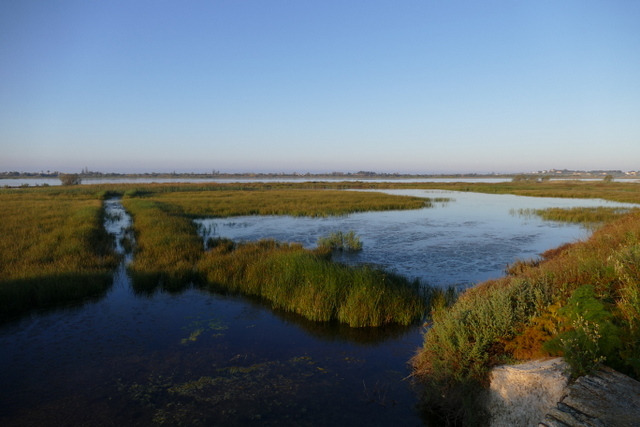 Pantano Longarini – looking beautiful in the early morning sunlight
Pantano Longarini – looking beautiful in the early morning sunlight
On the first day, I headed down to the marshes of Cuba and Longarini. Right from the outset it was clear that migrants had arrived overnight. Lots of Tree Pipits buzzed overhead and there were large numbers of Whinchat and Northern Wheatear in the fields. A careful look through them revealed the first Eastern Black-eared Wheatear of the trip – by the end of my visit I had found at least six, at various sites, all females.
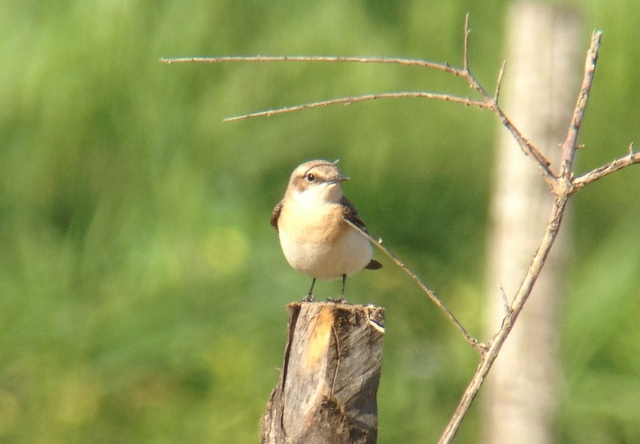 Eastern Black-eared Wheatear – a female
Eastern Black-eared Wheatear – a female
The waterbirds were the main reason for the visit here, and I particularly wanted to spend some time watching Ferruginous Ducks. I was not disappointed – at least 20 were on Pantano Cuba, which afforded the best views, with more distant birds also on Longarini and another three on Pantano Bruno. I saw them most days and was lucky to be able to watch them displaying on several occasions.
 Ferruginous Duck – a smart chestnut drake
Ferruginous Duck – a smart chestnut drake
There were lots of Garganey out on the water too, and a smattering of other ducks. A couple of pairs of Black-necked Grebe eventually showed themselves, amongst the more common Great Crested and Little Grebes. The Purple Swamphen were hard to see amongst the reeds, but the Purple Herons were more obliging. One of the highlights of the morning was seeing a flock of 9 Purple Herons, presumably migrants, fly in to Pantano Cuba. A flock of 19 Gull-billed Terns overhead was also quite a sight!
 Purple Heron – this one was trying to hide amongst the vegetation
Purple Heron – this one was trying to hide amongst the vegetation
On day 2, I headed over to the marshes at Vendicari early in the morning. The Greater Flamingos were the first things to catch the eye – at least 150 of them from the first hide overlooking the largest of the marshes. There were also lots of Spoonbills feeding, plus a few Squacco Herons and a single Black-crowned Night Heron standing on the mud.
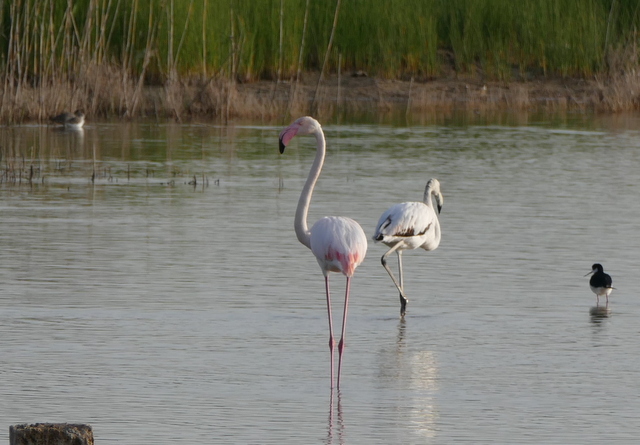 Greater Flamingo – always a spectacular bird to see
Greater Flamingo – always a spectacular bird to see
There has been lots of rain in Sicily this last winter, and the water levels at Cuba and Longarini were high – great for the ducks. In the shallower water at Vendicari, there were lots more waders. As well as plenty of Black-winged Stilts, there were several Marsh Sandpiper, lots of Wood Sandpiper including a flock of 10 which flew in over the beach, many Little Stints running around on the mud and a few moulting adult Curlew Sandpiper with them, to name but a few.
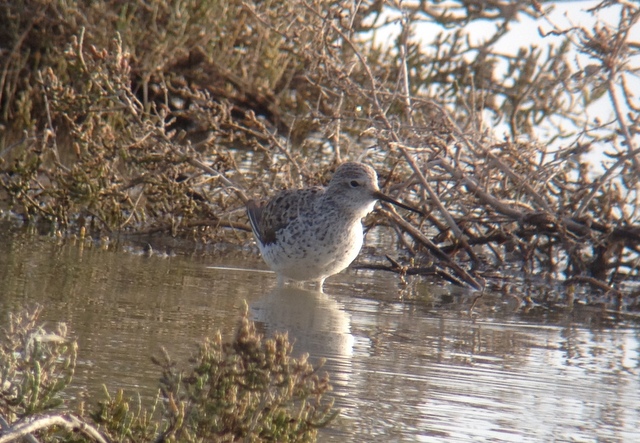 Marsh Sandpiper – there were several of this charming wader at Vendicari
Marsh Sandpiper – there were several of this charming wader at Vendicari
Vendicari is a very popular reserve for tourists and school groups so, as the number of people increased, I headed off north. Close to Siracusa, the headland of Capo Murro di Porco is renowned as one of the best places to find rare migrants in Sicily. A flock of 11 Bee-eaters was resting on the wires as I arrived, occasionally swooping out after flying insects. There were also lots of Tree Pipits amongst the low Mediterranean garrigue, but few signs of other migrants. However, the highlight was a single young (2nd cal year) Pallid Harrier which swept across the headland and away to the north. I was pleased to see this but little did I know what was to come tomorrow!
In the afternoon, I headed for Portopalo, the town at the south-east corner of Sicily. Down at the port, I spent some time watching the Audouin’s Gulls circling round amongst the fishing boats. Nearby, a couple of Slender-billed Gulls and a 1st summer Mediterranean Gull were standing on the beach with a Gull-billed Tern. Around onto the headland nearby and a few Scopoli’s and Yelkouan Shearwaters were lingering offshore – they were seen off most coastal headlands visited.
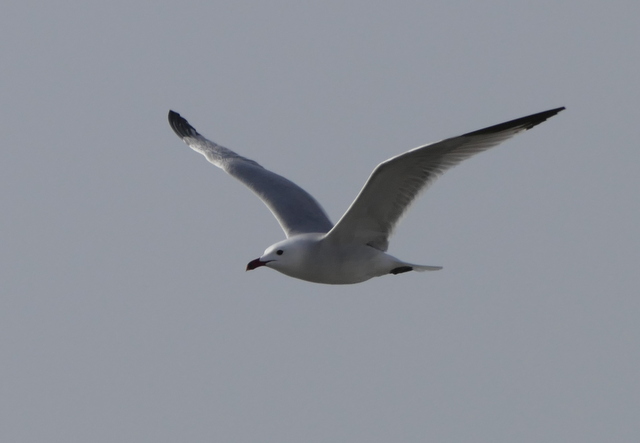 Audouin’s Gull – several were hanging around each of the fishing ports
Audouin’s Gull – several were hanging around each of the fishing ports
An early start on day 3 saw me heading up into the hills. Cava Grande de Casabile is a spectacular limestone gorge, and a popular tourist destination, but it can also be good for birds. I had particularly wanted to see the local race, cantillans, of Eastern Subalpine Warbler and here I managed to catch up with several of them, calling and singing. There were also lots of lovely hillside birds to look at, such as Rock Sparrows and Cirl Bunting. Despite this, it was a frustrating morning. A male Semi-collared Flycatcher hovered briefly by the entrance to the car park, but then was gone. After a thorough search, I briefly caught sight of it perched before it flew into the gardens and did not reappear. Eventually, I gave up and moved on.
It was still early so, on a whim, I decided to have another look at Capo Murro di Porco. It seemed even quieter than yesterday when I arrived. Then, around 11am, it all changed. A harrier appeared and, as it worked its way past really close, it was clear that it was a Pallid Harrier. Then another Pallid Harrier came past – at first, I wasn’t sure whether I might have been double counting. That marked the opening of the floodgates and, over the next 90 minutes it rained harriers. At least 35 Marsh Harriers and 20 ringtail harriers passed overhead – it was hard to keep count. Amongst the latter, Pallid seemed to significantly outnumber Montagu’s Harrier, but all of them appeared to be young (2nd calendar year) birds. Many of them continued out to the end of the headland and were watched disappearing out to see to the east.
 Pallid Harrier – one of many through Murro di Porco
Pallid Harrier – one of many through Murro di Porco
Harriers were not the only birds passing through. At least 25 Red-footed Falcons went past in the same time period, including a little flock of 9 birds which passed just overhead. There were also a couple of Lesser Kestrels and a Hobby. Hirundine migration had also picked up and there were lots of House and Sand Martins in the move. Swift migration had also started in earnest and amongst the hundreds of Common Swifts, I could pick out a small number of Alpine Swifts. It was a truly amazing sight to stand there and watch all these migrating birds streaming through. Then, just as quickly as it had started, it all dried up and the birds stopped coming.
That should have been enough for one day, but there was more to come. Late afternoon, I headed down to Portopalo harbour again. Out on the headland there was one small fenced off area amongst the low Mediterranean vegetation. There were no birds anywhere else but the fence was alive – with flycatchers the key feature. Amongst the Spotted & Pied Flycatchers was a cracking male Collared Flycatcher.
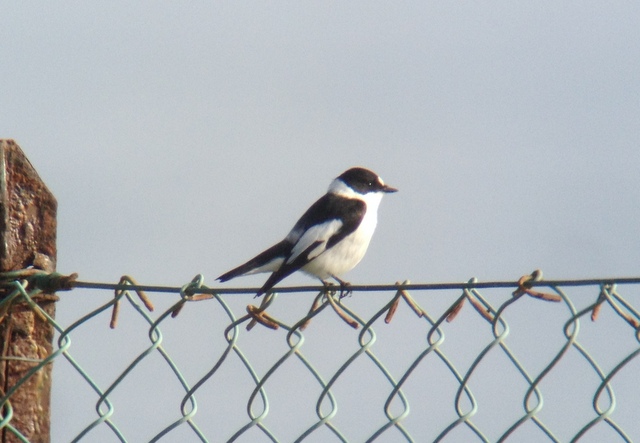 Collared Flycatcher – this very smart male was with Pied Flys at Portopalo
Collared Flycatcher – this very smart male was with Pied Flys at Portopalo
I finished the day back at Pantano Cuba, where two stunning White-winged Black Terns were hawking over the lake. A flock of at least 28 Blue-headed Wagtails dropped in to feed before heading off into the reeds to look for a roost site. A Red-throated Pipit flew over calling. What an awesome day, one I will never forget.
The following morning, there was no sign of any flycatchers at the site where they had been the day before near Portopalo – but they had obviously moved straight through. However, over at Pantano Cuba, there was more to see. A tight group of 13 Wood Sandpipers and 6 Greenshank were present, though struggled to find anywhere to land. We eventually found a handful of flycatchers as well, mostly Pied but also one Spotted Flycatcher. With them were a couple of smart Wood Warblers.
In the afternoon, I was very privileged to be taken to the site of a Lanner nest. For the first couple of hours, it was very quiet. Just a couple of Buzzards and a pair of Ravens up overhead. Then finally the male appeared, though strangely on closer inspection he appeared to be a young bird, born last year. The female appeared by the nest shortly afterwards. We watched them on and off for an hour or so, but their behaviour was confusing and suggested they may not be breeding this year. If the young male was the new other half of the pair, he may have been too young to breed successfully this year.
 Lanner – unfortunately perched up against the light
Lanner – unfortunately perched up against the light
On my final morning, I got up early and went for a quick look around Cuba and Longarini again. The Ferruginous Ducks put on an especially good show for me, just before I had to leave. While I was standing there, I could hear a Penduline Tit flying overhead calling but unfortunately I couldn’t get to see it.
I still had time to call in briefly at Capo Murro di Porco on my way to the airport and well worthwhile it was too! Another couple of Pallid Harriers passed overhead and out over the sea. Out by the old lighthouse, a small party of wheatears included two Eastern Black-eared Wheatears. Then a walk round one of the damper areas produced a couple of Tawny Pipits and a small flock of flava Wagtails. The latter included a single Black-headed Wagtail. The walk back to the car finally flushed a couple of Richard’s Pipits.
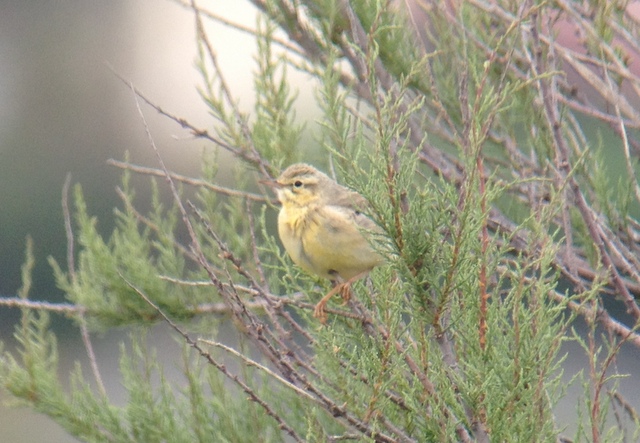 Tawny Pipit – this one appears to be covered in yellow pollen
Tawny Pipit – this one appears to be covered in yellow pollen
 ‘Sicilian’ Sparrows are a confusing mix of Italian & Spanish types
‘Sicilian’ Sparrows are a confusing mix of Italian & Spanish types
That is simply a few edited highlights of my trip. There were so many magic moments and I really cannot recommend it enough for a spring visit.
















